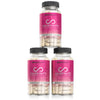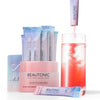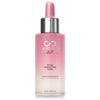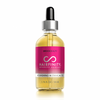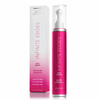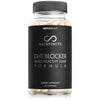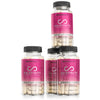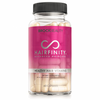
What are the side effects of hair colors?

Hair color is one of the most effective ways to change your appearance. Hair coloring offers an excellent opportunity to try out a new look. A number of people have been changing their hair colors since they started dyeing it. However, hair colors often come with side effects, and some of these side effects can be detrimental to one’s health.
Nevertheless, people now opt for homeopathic hair colors, which are made up of natural ingredients which will likely not harm your hair and health. This is due to the fact that homeopathic hair colors use gentler ingredients and fewer chemicals than most commercial hair colors.
In this article, we will be considering the general side effects of various hair colors, chemicals that are likely to trigger some of these side effects, and most importantly, we will get to see if homeopathic hair colors have side effects or not.
General Side Effects Of Various Hair Colors
Hair color comes with its own set of rules and side effects. Knowing them can help you take care of your hair and prevent it from suffering any damage. It’s a process that needs a lot of precaution, as the chemicals involved are potent. The side effects should not be taken lightly. In severe cases, they may need a doctor’s intervention.
Here are some of the common side effects of hair color:
- Itchy Scalp
There are plenty of reasons why a hair color might cause your scalp to itch. Leaving the product in for too long can irritate the skin, or you might be allergic to any ingredient in the formula. You may also be reacting because your scalp is dry; if your hair is naturally dry, you should use products formulated for dry hair even after you've colored it.
If you suspect an itching sensation is caused by an allergic reaction, wash off the dye immediately. If you think it's just irritation from leaving the product on too long, try using a medicated shampoo or moisturizing conditioner to soothe your scalp.
Itching could also be caused by using a poor quality product with harsh chemicals that don't agree with your head, so always perform a patch test before applying all over. Never leave hair color on longer than recommended without testing first!
- Burning Sensation
Some people report feeling a burning sensation on the scalp while the color is processed. This is especially common if the hair color has been applied incorrectly or not thoroughly rinsed out of the hair. When this happens, you may notice that your scalp is red and irritated. In mild cases, you can try rinsing off the color and trying again. If it persists, stop using the hair color and consult a doctor for advice on what to do about your symptoms.
- Irritated Skin
The most common side effect of hair color is irritated skin. This can be caused by sensitivity to the chemicals in the hair color, or it can be caused by skin conditions like eczema or other allergies.
Skin irritation can often be treated with topical creams or ointments, and over-the-counter treatments will usually do the job. If your itching and redness don't go away after several days of treatment, you should talk to your doctor about stronger medications that may help. Your doctor may also want to run some tests if your skin irritation doesn't improve after you've tried drugstore remedies for a few days.
- Redness of the Skin
Sometimes, hair color can cause allergic reactions. If you develop an allergic reaction while using a particular hair color, stop using it. Some signs of an allergic reaction include:
- a burning sensation or itching on your scalp
- redness of the skin
- swelling, blistering, crusting or scaling at the application site
If you are unsure whether you are having an allergic reaction to your hair color, talk with your doctor. Your doctor may refer you to a dermatologist for further evaluation and treatment.
If this is the first time you have colored your hair (or if you haven’t used that brand of color in years), do a patch test before applying it to your scalp and the entire head of hair. The patch test will help determine whether or not you have an allergy to the product ingredients.
- Inflammation
Inflammation is the body's way of protecting itself from infection caused by foreign organisms, such as bacteria and viruses. The problem with inflammation is that our own body's tissue can be damaged in the process of trying to protect us. However, inflammation can be treated using ice and heat.
- Nausea and Headache
Those who've ever walked out of the salon with a freshly colored coif may be familiar with feeling a little nauseous or having a headache after coloring their hair. Nausea and headaches are common side effects of the process.
Hair color is made up of chemicals that can cause allergic reactions, which may lead to nausea and headaches. Some people have an allergic reaction to the chemicals in hair color and can't use it again once they experience symptoms like nausea, dizziness, or headaches.
Dehydration is another possible cause of nausea and headaches after getting your hair colored. If you don't drink water while your hair is processed, you could become dehydrated. If you feel thirsty or lightheaded during your hair color appointment, ask for some water!
Dehydration can also make it harder for your body to get rid of toxic substances like the chemicals found in dyes. You should be drinking plenty of fluids before, during, and after getting your hair dyed, so your body has what it needs to maintain healthy organ function and eliminate toxic substances from harmful products
NOTE: If you suspect that your hair color caused you any of these side effects, stop using it immediately and see your doctor right away to determine whether or not they are related to your hair color.
Chemicals That Might Likely Trigger Side Effects Of Hair Colors
Most ingredients that make up a hair color contain chemicals that are detrimental to one’s health.
Below are some of the various chemicals to watch out for when you purchase your hair color:
A common culprit of allergic reactions is para-phenylenediamine (PPD). PPD is a chemical compound found in many permanent hair dyes, and its purpose is to help the dye penetrate your hair shaft.
However, over time PPD accumulates in the body and can cause severe allergic reactions, including anaphylactic shock. Because PPD can be absorbed through the skin, it’s essential to keep it out of contact with the skin as much as possible.
You should always wear gloves when handling hair color that contains PPD; this is both for your protection and because the product will adhere better if you don’t put it on bare hands. The same goes for your scalp: you don’t want to get any on your skin. This can be hard to do, especially if you are not experienced with coloring at home (which is why we recommend getting help from a professional).
Before applying a hair color that contains PPD, you can try using petroleum jelly or another substance that won’t harm your hair to create a barrier along your forehead and ears so that the product doesn’t touch your skin directly.
While it’s hard to avoid exposure to PPD, staying away from high-oxidation products will significantly reduce the amount of PPD you are exposed to. If you are sensitive to PPD, there are still options for you at the salon: look for brands that use plant-based dyes like henna and indigo or oxidative dyes with lower concentrations of PPD, which can still give you great results without irritating your scalp.
Ammonia is a colorless, pungent-smelling gas that is highly corrosive. It can cause irritation or chemical burns to the skin, eyes, and lungs.
Ammonia is used in hair color to open the hair cuticle allowing the dye to penetrate inside the hair shaft. The level of ammonia in hair color ranges from 5% to 12%.
3. Hydrogen Peroxide
Hydrogen peroxide is a strong oxidizer and is corrosive at high concentrations. Due to its sensitivity to light and temperature, it decomposes quickly and must be stored in a dark, cool environment.
Hydrogen peroxide is used in hair coloring products to lighten the natural color of the hair. You should avoid getting hair colors in your eyes, as hydrogen peroxide can cause irritation or chemical conjunctivitis.
4. Antifreeze ( Methylisothiazolinone and Methylchloroisothiazolinone)
This is a preservative that’s used in antifreeze. It is also used in many hair color products. It can cause dermatitis, which is an itchy, red rash. It can also cause an allergic reaction or even anaphylactic shock.
Dermatitis caused by this chemical may look like a rash and may be accompanied by itchiness or burning sensations. If you happen to be experiencing this reaction, wash your hair immediately and discontinue using the product containing these chemicals to prevent further skin irritation or damage.
Briefly, let's look at the side effects of homeopathic hair color, a safer alternative compared to the other hair color products.
Side Effects Of Homeopathic Hair Color
Most commercial hair colors rely on chemicals that can cause damage to your hair. The base of synthetic hair dyes is an active chemical that has been found to irritate the skin and trigger allergic reactions in many people.
However, Homeopathic hair color products have been formulated with ingredients found in nature. So, they work with your body, not against it.
When you compare homeopathic hair colors with other hair colors, the main difference is that it uses all-natural ingredients. Even people with sensitive skin can use homeopathic hair colors without experiencing any irritation or redness whatsoever.
Natural ingredients found in homeopathic hair color products include Henna, Amla, Indigo powder, turmeric, essential oils, and other natural ingredients.
Homeopathic hair color has no dangerous side effects. However, like all homeopathic preparations, homeopathic hair colors are designed to be absorbed through the skin and into the bloodstream. This means that if you have a condition that is made worse by a certain natural substance, then you might react to particular homeopathic hair colors.
For example, if you have hay fever caused by pollen, your body may react strongly to the pollen in an orange flower extract used in homeopathic hair color. However, it’s important to remember that this is not because of any dangers inherent in the product itself; you would need to avoid using products with ingredients from substances that make your hay fever worse.
Other possible side effects associated with homeopathic hair color products include;
- Fading of Hair Color
The most common side effect of using homeopathic hair colors is fading. This can be expected because it's natural — there are no chemicals involved in the coloring process and thus nothing to help the color stick.
The longer you let your hair absorb the dye, the more likely you will get a good result, so always make sure that you leave it on for as long as possible. If you wash your hair too often, then this will also cause fading, which means that it's important not to wash it every day if at all possible.
The natural oils produced by your scalp help keep this color vibrant, so not washing it as often will result in longer-lasting colors.
However, if you must wash daily, then try using a conditioner as well because this will keep your scalp from drying out and make it less likely for the color to fade prematurely.
- Temporary Discoloration of Skin
Another side effect of homeopathic hair colors is temporary discoloration of the skin that comes in contact with the hair color. This is comparable to what happens with peroxide-based dyes and can be easily cleaned off using soap and water.
Conclusion
While the side effects of homeopathic hair colors are typically minor, they are worth noting. You may want to take extra precautions if you or your stylist is inexperienced with homeopathic hair colors.
















